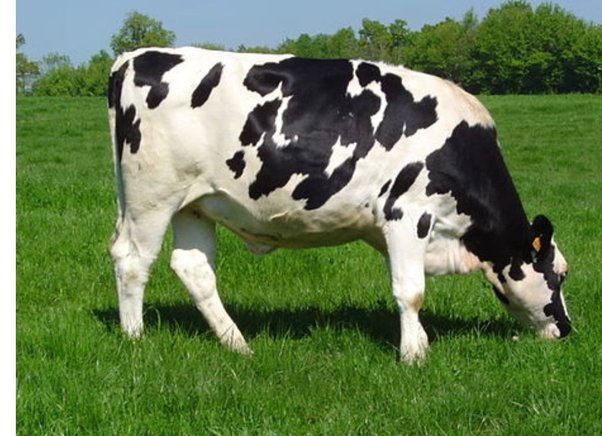Introduction
The Holstein cow is a popular dairy breed. It is known for its black-and-white markings and incredible milk production. Holsteins originated in the Netherlands. They were bred to provide huge quantities of milk. These cows are highly productive, often yielding greater milk than the other dairy breeds. They are popular because they are productive. Dairy farmers worldwide want them. Holsteins are also adaptable to many climates and control systems. This adds to their global preference.

Proper Health Care for Dairy Cattle
Good health care is critical. It is needed to keep up productivity, animal welfare, and farm profits in dairy farming. The following are some of the reasons why proper animal health care is important; Good productivity: healthy cows produce more milk of better quality. Frequent vet check-ups, vaccinations, and vitamins keep cows healthy. They minimize illnesses that could reduce milk yield.
Good animal welfare means ensuring the well-being of dairy cows. It’s not just an ethical duty. It also helps their lifespan and productivity. Good health care lowers complications. It also promotes better lives for animals. It includes prevention and timely treatment.
Healthy cows are more productive. By using proper healthcare, farmers can cut costs for controlling disease. They can also reduce deaths. This all leads to increased farm profits. Moreover, healthier cows lead to higher milk quality, attracting higher costs.
Unveiling the Holstein
Holstein cows are easy to recognize. This is due to their distinctive black-and-white markings. These make them one of the most iconic breeds in the dairy industry. Another great thing about Holsteins is their huge size. Mature Holstein cows usually weigh 1,300 to 1,500 pounds. These traits make them stand out visually. They also help their high milk production. Their large size supports a huge digestive system. This system lets them eat lots of feed.
Holstein cows live for 10 to 15 years on average. But, this could vary. It depends on factors like care and health. During their productive years, Holsteins are known for their brilliant milk production. They make huge volumes, regularly over 10,000 liters per lactation. This excellent output is the main reason why Holsteins dominate the global dairy industry. Their milk yield is unmatched by other breeds. This ensures a steady and huge supply of dairy products.
However, the high-production nature of Holsteins comes with certain health vulnerabilities. The demands of these milky breeds could make them prone to problems. These include mastitis, ketosis, and reproductive issues. Cows face health challenges. These need careful control and early healthcare measures. These steps keep the cows effective and healthy for life. So, to prevent these risks and keep Holstein cows healthy and productive, they need a balanced diet, regular fitness checks, and vet visits.
Safeguarding Your Herd: Common Holstein Cow Health Concerns
Holstein cows face many health problems. Metabolic issues are a big part. They include ketosis and milk fever (hypocalcemia). Ketosis happens when cows burn fat reserves too quickly. This is due to not eating enough. It causes an excess of ketones in the blood. Signs and symptoms are; reduced milk yield, weight reduction, and lethargy. Prevention techniques include providing a balanced food plan. It should be rich in energy nutrients, especially around calving. You should also monitor body conditions. Milk fever is caused by low blood calcium levels around calving. It can lead to weak muscles, tremors, and, in severe cases, collapsing. Prevention includes dietary control to get enough calcium and vitamin D. This is done with calcium supplements at calving.
Mastitis is an inflammation of the udder. It is another big health problem for Holstein cows. It hurts milk quality and yield. It can be a result of bacterial infections and is classified into clinical, subclinical, and continual types. Clinical mastitis shows swelling, redness, and odd milk. Subclinical mastitis has no signs but reduces milk. Prevention includes ensuring milking hygiene. It also involves using the right milking techniques. And, regularly checking and cleaning the udder and milking system. Udder health control is crucial, as untreated mastitis can lead to severe infections and financial losses.
Laminitis is hoof inflammation. It often comes from an unbalanced food plan and obese cows. This leads to lameness and lower productivity. Signs include limping, abnormal gait, and reluctance in movement. Preventive measures focus on a balanced diet to avoid digestive upsets. They also focus on keeping cows at a proper weight. And they focus on normal hoof trimming and care. Also, reproductive issues are common in high-production Holsteins. These issues include challenges with birth and calving. Complications include abnormal estrous cycles, retained placenta, and problems in calving. Timely vet care and good breeding practices are critical. They are needed to deal with these issues well.
Frequent veterinary checkups and vaccinations are important for preserving herd health. Regular vet visits help find and treat health problems early. This keeps cows productive and healthy. Vaccinations protect against common infections. They also reduce illness and promote herd immunity.
Proactive Prevention: Best Practices for Maintaining Holstein Cow Health
Promoting good health for Holstein cows involves various techniques. Balanced nutrition is key. It requires a proper feed formula and strict quality control. These ensure the Holsteins get enough energy, protein, vitamins, and minerals. Clean and comfortable housing is critical. It means keeping stalls clean. It also means providing good ventilation and enough space. These things reduce strain and prevent breathing problems.
Trimming hooves occasionally prevent lameness and soreness. It ensures cows can move freely and stay productive. Proper stress management is key. It involves removing stressors like overcrowding and noise. These stressors can harm cow fitness and milk yield. Additionally, biosecurity measures are crucial to protect cows from infectious sicknesses. This relates to protocols. They include controlling farm access, using disinfectants, and tracking herd health. Doing these things can greatly help dairy farmers. They can improve their Holstein cows’ health, welfare, and productivity.
Recognizing the Signs: Early Detection of Health Issues in Holsteins
Spotting signs of sickness in Holstein cows is essential. It allows for timely intervention and preserving herd health. Farmers have to watch for odd changes in food appetite, milk production, or conduct. These changes include eating less, sudden drop in milk yield, lethargy, or strange discharges from the nostril, eyes, or udder. Visible signs of discomfort are key. Lameness, abnormal gait, or problem respiration are also signs. They show that a cow might be ill. Also, temperature often shows contamination or stress. It must be checked often in regular health checks. Farmers ought to be observant and attentive to those symptoms. Spotting them early can prevent the issues from becoming critical health problems. This ensures the well-being and productivity of their Holstein cows.
Conclusion
Prioritizing Holstein’s cow health is important for a successful dairy operation. Healthy cows are more effective and give higher-quality milk. They also help farm profits. Preventive care is essential. It includes balanced nutrients, clean housing, regular hoof trimming, and stress management. It maintains good health.
Early detection of health issues comes from closely monitoring and spotting early symptoms. It allows for quick treatment and reduces harm to productivity. Working with a qualified veterinarian ensures that health techniques are done right. It also ensures that any rising issues are addressed quickly. This protects the well-being and performance of the dairy herd.

